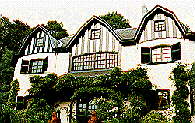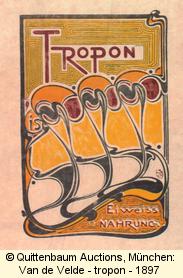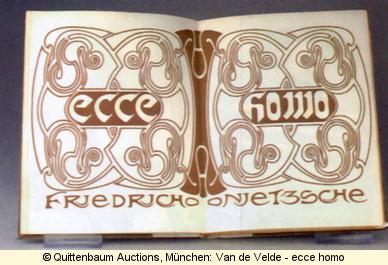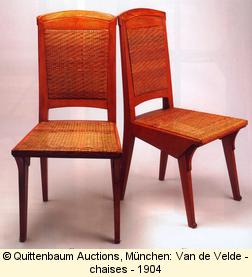Henry Van de Velde (1863-1957)
Belgian
designer and architect  Van de Velde is
the most international artist of the Art Nouveau movement and one of
the major. Born in Antwerpen, he started as a painter influenced by
divisionnism. He built his first house for himself in Brussels
("Bloemenwerf"). He designed every detail : when I visited it in the
early 1990ies, I could still see the heater in an original Van de Velde
Art Nouveau style. As he never studied architecture and he was paying
for his house, he could feel free from the old styles more than other
architects. He gain a large succes in Berlin from 1900 for he interior
designs. And then he was one of the founders of the decorative arts
shool of Weimar in 1902. This school was later called the "Bauhaus"
when it was directed by Gropius. In 1910-11, he tried to establish in
Paris with no success. He left Weimar in 1917 for Swidzerland during 2
years and then 6 years in Holland but without any architectural
success. In the 1920ies his architecture turn to functionalism and had
a lot of influence on other mosern architects. He got an other period
of success from 1926 when he returned to Brussels. He spent his last
ten years in Switzerland, far from the spotlights.
Van de Velde is
the most international artist of the Art Nouveau movement and one of
the major. Born in Antwerpen, he started as a painter influenced by
divisionnism. He built his first house for himself in Brussels
("Bloemenwerf"). He designed every detail : when I visited it in the
early 1990ies, I could still see the heater in an original Van de Velde
Art Nouveau style. As he never studied architecture and he was paying
for his house, he could feel free from the old styles more than other
architects. He gain a large succes in Berlin from 1900 for he interior
designs. And then he was one of the founders of the decorative arts
shool of Weimar in 1902. This school was later called the "Bauhaus"
when it was directed by Gropius. In 1910-11, he tried to establish in
Paris with no success. He left Weimar in 1917 for Swidzerland during 2
years and then 6 years in Holland but without any architectural
success. In the 1920ies his architecture turn to functionalism and had
a lot of influence on other mosern architects. He got an other period
of success from 1926 when he returned to Brussels. He spent his last
ten years in Switzerland, far from the spotlights.
 His Art Nouveau designs, always bent with dynamic curves, are some of the
most typical of the period. They often turn to abstraction like in the
placard for the Tropon firm or the book cover for "Ecce Homo" by
Nietzche.
His Art Nouveau designs, always bent with dynamic curves, are some of the
most typical of the period. They often turn to abstraction like in the
placard for the Tropon firm or the book cover for "Ecce Homo" by
Nietzche.
His Art Nouveau furniture often opposed
these dynamic lines with massive shapes so as his buildings. He was
reproached to build his buildings like furniture. Nevertheless, Henry
Van de Velde is one of the Art Nouveau architects who makes most the
shapes give an emotion.
Main buildings
- Bloemenwerf in Brussels in 1895
- Folkwang Museum in Hagen in 1901
- Werkbund Theatre in Koln - 1914
- Rijksmuseum Kröller-Müller at
Otterloo (Netherlands) - 1936-38

 RSS
RSS


